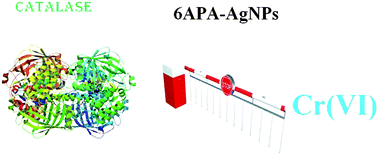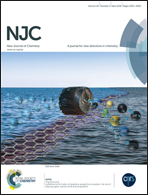Chromium scavenging ability of silver nanoparticles in human erythrocytes, real samples and their effect on the catalase enzyme†
Abstract
Herein, we report a facile method for the synthesis of silver nanoparticles coated with 6-aminopenicillanic acid (6APA–AgNPs) by using triethylamine as a reaction promoter. UV-vis, FTIR, AFM, and MALDI-TOF-MS analyses were used to ensure the formation of nanoparticles. The 6APA–AgNPs were brought in contact with 21 different metal cations in order to evaluate their chemosensing potential. Under the optimal conditions, 6APA–AgNPs allowed us to detect Cr(VI) selectively in the range of 13.3-266.67 μM with a detection limit of 3.4 μM. The association constant Ka of 6APA–AgNPs–Cr(VI) was found to be 0.396 mM−1 using the Benesi Hildebrand plot. The signal transduction of 6APA–AgNPs in the presence of Cr(VI) was investigated in the tap and subsurface water supplies, human plasma and electroplating industrial waste. Since the oligodynamic effect of silver nanoparticles is well recognized we also evaluated their effect on the activity of the antioxidant enzyme catalase as an indication of hemolysis. The 6APA–AgNPs are hemocompatible and also scavenged Cr(VI) effectively in human erythrocytes, which is a geno-toxin and known to modulate the catalase activity.


 Please wait while we load your content...
Please wait while we load your content...